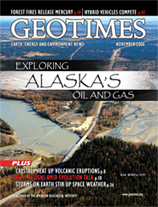
|
|
|||||||||||||||
|
|
|
|||||||||||||||
|
Geophenomena
Print
Exclusive
Energy & Resources Print
Exclusive Trends & Innovations Print
Exclusive Education & Outreach
|
|||||||||||||||
|
Guarding Against Tsunamis: What Does It Mean To Be Ready? Technical systems to warn residents of an impeding tsunami are not enough. Laura S. L. Kong Political Scene A Winding Path to the Energy Hill The route to the energy sector and politics came unexpectedly to one geoscientist. Allyson K. Anderson Geologic Column Thinking space Is packing the trunk of your car for a roadtrip a personal specialty? Then you might be a geoscientist, or at least think like one. Lisa Rossbacher |
Mark D. Myers: Politics, pipelines and permafrost Geomedia Benchmarks Print
Exclusive
|
|||||||||||||||
 ON
THE COVER ON
THE COVER An aerial view shows the Trans-Alaska Pipeline System and Richardson Highway, where they cross the Tanana River at its confluence with the Delta River, about 13 kilometers north of Delta Junction in Alaska. South of the Tanana River, the pipeline is buried where it crosses farmland in glacial outwash deposits. In two current proposals for a natural gas pipeline from the North Slope, the gas pipeline would follow the oil pipeline to this area and then turn southeast to follow the Alaska Highway to a hub in Canada. In a third proposal, the gas pipeline would follow the oil pipeline for its entire route from Prudhoe Bay to Valdez. Read more in this issue. Photo by Rod Combellick. |
Next month: Highlights: Year in Review
|
| SUBSCRIBE | CLASSIFIEDS | ADVERTISE | FOR AUTHORS | CONTACT US | ARCHIVES | SEARCH |
 |
Geotimes Home | AGI Home | Information Services | Geoscience Education | Public Policy | Programs | Publications | Careers |